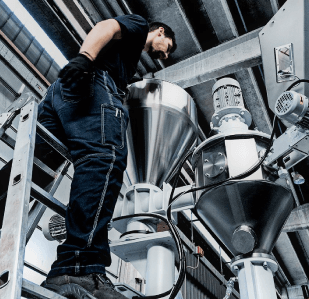In Brief
Co-extrusion is the creation of a multi-layer system, obtained by feeding the extruder head with more than one material, each coming from a different cylinder. Passing through the die, the different flows are organized and compose the different layers of the object. On a physical level, this is guaranteed by the viscosity of the polymers, which prevents mixing and allows the homogeneous distribution of one material over the other.
As for simple extrusion, polymers must plasticize and flow without degrading, so pressure and temperature profiles need accurate control; moreover, the residence time of the material in the cylinder must be as limited as possible.
Types of applications
The advantages of co-extrusion and the applications in which it is used are many and the market is growing as new applications are made. From "breathable" packaging in the medical field to barrier coatings for food and beverages and fluid handling in the automotive sector, co-extrusion is one of the best alternatives for producing high-performance components. Properties such as thermal, moisture and oxygen resistance, mechanical properties, aesthetics and insulation are combined to produce functional components with great potential. There can also be significant savings due to the possibility of producing components with a large proportion of recycled material and limiting virgin or high-value, functionalized and colored material to only the surface layers.
The fundamental advantage of co-extrusion is the possibility to produce plastic-drawn products in which there are two parts of different rigidity, which can be used in different industrial sectors, from construction to food, with contained costs and long-lasting results.
As far as the construction sector and the production of pipes are concerned, the success of the technology strongly depends on the materials used and on the design of the plant; the polymers must plasticize, flow in the cylinders and couple with the right temperatures, in the right relative thickness ratios of the layers, and above all with a laminar motion. If this condition does not occur, a random mixing of phases instead of a multilayer is observed, due to the difference in viscosity of the polymers.
Process Criticality
Compenetration between the different layers is a typical defect, which can be limited by predicting the right length of the path that the different polymers travel together in the extruder. The main problems related to the co-extrusion process concern the interfaces between the layers, in particular their deformation and instability. The interfaces between the different materials play a crucial role in the success of the multilayer; extensive instability in fact compromises the final result, causing distortion and decoupling between the polymeric flows. Instability at the interface is an internal defect and typically manifests itself through zigzag or wavy effects.
Also, excessive polymer viscosity mismatch causes several negative consequences on the co-extrudate exiting the matrix. In addition to a turbulent rather than laminar flow condition, the predominant effect is extensive encapsulation of the higher viscosity material by the lower viscosity material; this effect is most visible as the viscosity difference between the two polymers increases.
If the melt temperature is not homogeneous, the viscosity takes on different local values and this can lead to more or less evident variations in the thickness of the layers. In fact, if one melt flows more easily than another, the layer related to that material will be thicker than that of the polymer that moves with more difficulty.
If one or more layers degrade due to an incorrect design of the system and the temperature and pressure profiles, discoloration of the pipe can be observed, while ovalization occurs if the gauge is worn or if the material is not at a suitable temperature. When higher shear values are reached, even more obvious instabilities can be observed such as stick-slip, which is a macroscopic slippage of the surface.
Bausano's co-extruding solution
However, the rheological aspect remains fundamental for the understanding of the problems related to this technology; above all, it has been demonstrated that polymer viscosity represents the most important parameter for the determination and, therefore, the solution of the problems.
Bausano offers a wide range of co-extruders used in the medical industry, research centers and universities, as well as in all plastic industries.
These co-extruders are able to process all thermoplastic materials such as PVC, PU, PE, PP, PC, PA, PMMA, PSU, PBT, LCP, PLG, PEEK, FEP, ETFE, PVDF and are mainly used for the production of:
- medical tubes and multilumen tubes
- co-extruded tubes
- technical profiles, plates, sheets
- co-extrusion of colored strips on tubes, cables and profiles.





.jpeg)
.jpeg)